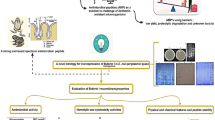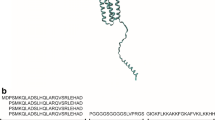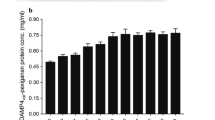Abstract
Antimicrobial peptides (AMPs) are a kind of small molecular peptide that an organism produces to resist the invasion of foreign microorganisms. AMP BSN-37 is a bovine AMP that exhibits high antibacterial activity. In this paper, the optimized gene AMP BSN-37 was cloned into pCold-SUMO for fusion expression by recombinant DNA technology. The gene sequence of AMP BSN-37 was obtained by codons reverse translation, and the codons were optimized according to the codons preference of Escherichia coli (E. coli). The recombinant plasmid was constructed and identified by PCR, enzyme digestion and sequencing. Then the recombinant plasmid was transformed into BL21 E. coli to induce expression, and the IPTG concentration and time were optimized. The expressed soluble fusion protein SUMO-BSN-37 was purified by chromatography and then cleaved by SUMO proteases to release BSN-37. SDS-PAGE electrophoresis and Western blotting were used for identification. The recombinant plasmid pCold-SUMO-BSN-37 was obtained, and the fusion AMP BSN-37 was preliminarily expressed in BL21. After optimization, the optimal expression condition was 37 ℃ with 0.4 µM IPTG and 6 h incubation. Under optimal conditions, a large amount of fusion AMP BSN-37 was obtained by purification. Western blotting showed that the fusion peptide was successfully expressed and had good activity. The expressed BSN-37 showed antimicrobial activity similar to that of synthesized BSN-37. In this study, soluble expression products of AMP BSN-37 were obtained, and the problem regarding the limited source of AMP BSN-37 could be effectively solved, laying a foundation for further research on AMP BSN-37.







Similar content being viewed by others
Data Availability
The datasets used and/or analyzed during the current study are available from the corresponding author on reasonable request.
Change history
15 April 2024
‘of’ word added in affiliation.
References
Shrestha AB, Pokharel P, Sapkota UH, Shrestha S, Mohamed SA, Khanal S, Jha SK, Mohanty A, Padhi BK, Asija A, Sedhai YR, Rijal R, Singh K, Chattu VK, Rodriguez-Morales AJ, Barboza JJ, Sah R (2023) Drug resistance patterns of commonly used antibiotics for the treatment of Helicobacter pylori infection among south asian countries: a systematic review and Meta-analysis. Trop Med Infect Dis 8(3):172
Osorio C, Garzon L, Jaimes D, Silva E, Bustos RH (2021) Impact on Antibiotic Resistance, Therapeutic Success, and Control of Side Effects in Therapeutic Drug Monitoring (TDM) of daptomycin: a scoping review. Antibiotics-Basel 10(3):263
Al-Jassim N, Ansari MI, Harb M, Hong PY (2015) Removal of bacterial contaminants and antibiotic resistance genes by conventional wastewater treatment processes in Saudi Arabia: is the treated wastewater safe to reuse for agricultural irrigation? Water Res 73:277–290
Wilson GM, Fitzpatrick MA, Walding K, Gonzalez B, Schweizer ML, Suda KJ, Evans CT (2021) Evaluating the clinical effectiveness of new beta-lactam/beta-lactamase inhibitor combination antibiotics: a systematic literature review and meta-analysis. Antimicrob Steward Health Epidemiol 1(1):e53
Bloem A, Bax HI, Yusuf E, Verkaik NJ (2021) New-generation antibiotics for treatment of Gram-Positive infections: a review with Focus on Endocarditis and Osteomyelitis. J Clin Med 10(8):1743
Annunziato G, Costantino G (2020) Antimicrobial peptides (AMPs): a patent review (2015–2020). Expert Opin Ther Pat 30(12):931–947
Vorland LH (2001) [Natural antimicrobial peptides–promising new antibiotics or a problem later on?]. Tidsskr Nor Laegeforen 121(27):3191–3196
Hancock RE, Patrzykat A (2002) Clinical development of cationic antimicrobial peptides: from natural to novel antibiotics. Curr Drug Targets Infect Disord 2(1):79–83
Vineeth Kumar TV, Sanil G (2017) A review of the mechanism of action of Amphibian antimicrobial peptides focusing on peptide-membrane Interaction and membrane curvature. Curr Protein Pept Sci 18(12):1263–1272
Park SC, Son H, Kim YM, Lee JK, Park S, Lim HS, Lee JR, Jang MK (2022) Design of antimicrobial peptides with cell-selective activity and membrane-acting mechanism against drug-resistant Bacteria. Antibiot (Basel) 11(11):1169
Wu M, Maier E, Benz R, Hancock RE (1999) Mechanism of interaction of different classes of cationic antimicrobial peptides with planar bilayers and with the cytoplasmic membrane of Escherichia coli. Biochemistry 38(22):7235–7242
Mardirossian M, Barriere Q, Timchenko T, Muller C, Pacor S, Mergaert P, Scocchi M, Wilson DN (2018) Fragments of the Nonlytic Proline-Rich Antimicrobial peptide Bac5 kill Escherichia coli cells by inhibiting protein synthesis. Antimicrob Agents Ch 62(8):e00534–e00518
Apliak IV, Kagan GI (1964) [Effect of Antimicrobial Substances from Myrtle on the Heat resistance of spores of Bac. Mesentericus Ruber] Mikrobiol Zh 26:27–31
Wang Q, Xu YZ, Hu JH (2022) Intracellular mechanism of antimicrobial peptide HJH-3 against Salmonella pullorum. Rsc Adv 12(23):14485–14491
Yang L, Sun YW, Xu YZ, Hang BL, Wang L, Zhen K, Hu B, Chen YN, Xia XJ, Hu JH (2020) Antibacterial peptide BSN-37 kills Extra- and Intra-Cellular Salmonella enterica Serovar Typhimurium by a Nonlytic Mode of Action. Front Microbiol 11:174
Hoelscher MP, Forner J, Calderone S, Kramer C, Taylor Z, Loiacono FV, Agrawal S, Karcher D, Moratti F, Kroop X, Bock R (2022) Expression strategies for the efficient synthesis of antimicrobial peptides in plastids. Nat Commun 13(1):5856
Saitoh H, Uwada J, Azusa K (2009) Strategies for the expression of SUMO-modified target proteins in Escherichia coli. Methods Mol Biol 497:211–221
Deng T, Ge H, He H, Liu Y, Zhai C, Feng L, Yi L (2017) The heterologous expression strategies of antimicrobial peptides in microbial systems. Protein Expr Purif 140:52–59
Kim DS, Kim SW, Song JM, Kim SY, Kwon KC (2019) A new prokaryotic expression vector for the expression of antimicrobial peptide abaecin using SUMO fusion tag. BMC Biotechnol 19(1):13
Park AR, Kim SW, Kim SY, Kwon KC (2021) Expression of Antimicrobial peptide (AMP), Cecropin B, in a fused form to SUMO tag with or without three-Glycine Linker in Escherichia coli and evaluation of bacteriolytic activity of the purified AMP. Probiotics Antimicro 13(6):1780–1789
Mo Q, Fu A, Lin Z, Wang W, Gong L, Li W (2018) Expression and purification of antimicrobial peptide AP2 using SUMO fusion partner technology in Escherichia coli. Lett Appl Microbiol 67(6):606–613
Steinberg DA, Lehrer RI (1997) Designer assays for antimicrobial peptides. Disputing the “one-size-fits-all” theory. Methods Mol Biol 78:169–186
Magrone T, Russo MA, Jirillo E (2018) Antimicrobial peptides: Phylogenic Sources and Biological Activities. First of two parts. Curr Pharm Design 24(10):1043–1053
Ishida H, Nguyen LT, Gopal R, Aizawa T, Vogel HJ (2016) Overexpression of Antimicrobial, Anticancer, and transmembrane peptides in Escherichia coli through a calmodulin-peptide Fusion System. J Am Chem Soc 138(35):11318–11326
Zhang J, Movahedi A, Wei Z, Sang M, Wu X, Wang M, Wei H, Pan H, Yin T, Zhuge Q (2016) High-level SUMO-mediated fusion expression of ABP-dHC-cecropin A from multiple joined genes in Escherichia coli. Anal Biochem 509:15–23
Vu TT, Jeong B, Yu J, Koo BK, Jo SH, Robinson RC, Choe H (2014) Soluble prokaryotic expression and purification of crotamine using an N-terminal maltose-binding protein tag. Toxicon 92:157–165
Sun Y, Li Q, Li Z, Zhang Y, Zhao J, Wang L (2012) Molecular cloning, expression, purification, and functional characterization of palustrin-2CE, an antimicrobial peptide of Rana chensinensis. Biosci Biotechnol Biochem 76(1):157–162
Peng H, Yang M, Huang WS, Ding J, Qu HD, Cai JJ, Zhang N, Wang KJ (2010) Soluble expression and purification of a crab antimicrobial peptide scygonadin in different expression plasmids and analysis of its antimicrobial activity. Protein Expr Purif 70(1):109–115
Li X, Leong SS (2011) A chromatography-focused bioprocess that eliminates soluble aggregation for bioactive production of a new antimicrobial peptide candidate. J Chromatogr A 1218(23):3654–3659
Pan D, Zha X, Yu X, Wu Y (2016) Enhanced expression of soluble human papillomavirus l1 through coexpression of molecular chaperonin in escherichia coli. Protein Exp Purif 120:92–98
Luan C, Zhang HW, Song DG, Xie YG, Feng J, Wang YZ (2014) Expressing antimicrobial peptide cathelicidin-BF in Bacillus subtilis using SUMO technology. Appl Microbiol Biotechnol 98(8):3651–3658
Azari M, Asad S, Mehrnia MR (2020) Heterologous production of porcine derived antimicrobial peptide PR-39 in Escherichia coli using SUMO and intein fusion systems. Protein Expr Purif 169:105568
Li Y (2013) Production of human antimicrobial peptide LL-37 in Escherichia coli using a thioredoxin-SUMO dual fusion system. Protein Expr Purif 87(2):72–78
Li Y (2009) Carrier proteins for fusion expression of antimicrobial peptides in Escherichia coli. Biotechnol Appl Biochem 54(1):1–9
Funding
This research was funded by the National Natural Science Foundation of China (32273042), the Science and Technology Innovation Team Support Program of the University of Henan Province (20IRTSTHN025), Postdoctoral Research Sponsorship in Henan Province (2015105), and Scientific and Technological Breakthrough Foundation of Henan Province (232102110086).
Author information
Authors and Affiliations
Contributions
Data curation, Y.X. and M.D; Funding acquisition, Y.X. and J.H.; Methodology, Q.W., B.H. and Y.S.; Resources, H.Z. and Y.X.; Supervision, G.P.
Corresponding authors
Ethics declarations
Competing Interests
The authors declare no competing interests.
conflict of Interest
The authors declare that they have no conflict of interest.
Additional information
Publisher’s Note
Springer Nature remains neutral with regard to jurisdictional claims in published maps and institutional affiliations.
Rights and permissions
Springer Nature or its licensor (e.g. a society or other partner) holds exclusive rights to this article under a publishing agreement with the author(s) or other rightsholder(s); author self-archiving of the accepted manuscript version of this article is solely governed by the terms of such publishing agreement and applicable law.
About this article
Cite this article
Xu, Y., Dong, M., Wang, Q. et al. Soluble Expression of Antimicrobial Peptide BSN-37 from Escherichia coli by SUMO Fusion Technology. Protein J 42, 563–574 (2023). https://doi.org/10.1007/s10930-023-10144-2
Accepted:
Published:
Issue Date:
DOI: https://doi.org/10.1007/s10930-023-10144-2




